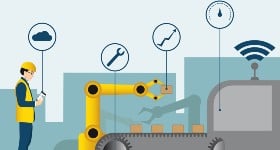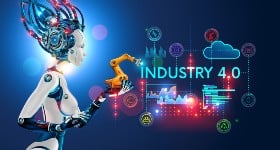In the early 1960s, more than 10 percent of the working population in the United States was employed in factories. Only 4 percent of the workforce is employed in factories today. In the early 70s, 5 percent of the labour force was employed as secretaries. Today, less than 3 percent of the working population are secretaries. Thanks to advanced robotic technology and better computer software, factories can still function without workers and professionals can be just as productive without secretaries. Amidst today's public debate about repercussions of advanced robotics and artificial intelligence, along comes IoT (Internet of Things).
What Does Research Say?
The amount of evidence suggesting that automation and robotics will take over a significant percentage of occupations in the United States is overwhelming. A 2016 analysis by McKinsey & Co. found that 45 percent of tasks individuals are paid to perform can be automated if currently demonstrated technology is adopted.
Gartner predicts that about 30 percent of occupations will be converted to smart machines, robots, or software in the next ten years. A recent survey by researchers at Oxford suggests that in the next two decades, nearly 50 percent of occupations in the United States will be automated. If these studies are anything to go by, the situation doesn't look good for the American population.
How Does IoT Affect The Job Market?
But how does IoT fit into all this? The Internet of Things is a broad term used to refer to a scenario where non-digitized objects/devices are ushered into the realm of the World Wide Web. These 'things' encompass anything from cars, ovens, coffee machines et cetera.
Once connected, these devices become uniquely distinguishable and can interact with many other objects connected to the network. IoT is set to connect millions of devices to the internet, including wearable devices such as smartwatches and internet goggles. As this happens, there will be a need for ways in which users can interact with the data around them without the use of screens — computers, smartphones, and tablets.
For that to happen, existing web data will need to be scraped, repackaged, and restored to make it consumable in different IoT contexts. What this means is plenty of opportunities for IT professionals with data scraping skills. At the same time, by the year 2020, as many as 250,000 IoT applications will have been developed, which also means more opportunities for developers. However, the Industrial Internet of Things (IoT) will have the most impact on the job market.
The Industrial Internet of Things (IoT)
The Industrial Internet of Things (IoT) refers to a network of interconnected machines, devices, other industrial gadgets. IIoT will lead to the automation of most industrial activities thus driving efficiency into the production process. Some occupations will definitely be affected, but the vast majority of managers are of the opinion that the net effect of IoT driven automation will be job creation.
How's That Exactly?
The use of robotics, automation, and analytics will lead to a more knowledge-intensive performance. The outcome of knowledge intensive work is quality and high productivity alongside a safer, more engaging work experience. This will result in the production of high-quality goods which will, in turn, increase sales. Companies will be able to offer better hourly rates and hire more employees to meet the increasing demand for their products.
At the industrial level, the internet of things will create more jobs than it will take away. New technology always seems to be destroying manual jobs but creates demand for high-skilled jobs. Just like the industrial and technological revolutions before it, IoT will replace unskilled jobs with high-skilled occupations and instead of fearing for our jobs, we should focus on expanding our skill sets.
Edited by
Ken Briodagh





